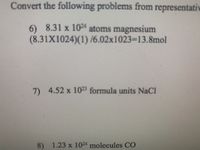
Introduction to General, Organic and Biochemistry
11th Edition
ISBN: 9781285869759
Author: Frederick A. Bettelheim, William H. Brown, Mary K. Campbell, Shawn O. Farrell, Omar Torres
Publisher: Cengage Learning
expand_more
expand_more
format_list_bulleted
Concept explainers
Question
thumb_up100%
Please convert problem seven into from representative to moles and show the steps please.

Transcribed Image Text:Convert the following problems from representativ
6) 8.31 x 104 atoms magnesium
(8.31X1024)(1) /6.02x1023=13.8mol
7) 4.52 x 1023 formula units NaCl
8) 1.23 x 104 molecules CO
Expert Solution
This question has been solved!
Explore an expertly crafted, step-by-step solution for a thorough understanding of key concepts.
This is a popular solution
Trending nowThis is a popular solution!
Step by stepSolved in 2 steps

Knowledge Booster
Learn more about
Need a deep-dive on the concept behind this application? Look no further. Learn more about this topic, chemistry and related others by exploring similar questions and additional content below.Similar questions
- I would like for this problem to be written in the same format as this picture below. (picture is an example picture.) Answer Correctly. Please calculate the mass in grams for: 8.0 mol lead oxide (PbO)arrow_forwardCaffeine (MM = 194.2 g/mol) is a small molecule that many people ingest for its stimulant effects. Elemental %3D analysis shows that this compound contains 49.5% C, 5.19% H, 28.9% N and 16.5% O by mass. (a) Determine the empirical formula of Caffeine? (b) Determine the molecular formula of Caffeine? Clearly show your work.arrow_forwardWhat is this?arrow_forward
- Aa.103.arrow_forwardPlease help me, and double and triple check your answers previous tutors got questions wrongarrow_forwardPractice 2-2 A solution is prepared by dissolving 2.00 kg of solute is enough solvent to make 50.0 kg of solution. What is the percentage concentration of the solution? Practice 2-3 What mass of sodium chloride and what volume of water are needed to prepare 5.00 mL of a 0.89% by mass saline solution?( Saline solution is the everyday language pharse that refers to a sodium chloride solution.) The density of the solution is equal to the density of water to ±0.01 g/mL. Practice 2-4 What is the molarity of a solution that was prepared by adding 10.4 g of potassium chloride to enough water to make a total of 5.00 mL of solution? Practice 2-5 Determine the mass of sodium sulfate (in grams) dissolved in 2.00 L of a 0.12 M sodium sulfate solution Practice 2-6 A technician dissolves 5.29 g of ammonium sulfate in water to make a 0.10 –M solution. What volume of solution did she make? Answer in milliliters. Practice 2-7 A solution is prepared by dissolving 80.0 mg phosphate in 25 mL water.…arrow_forward
- m/course.html?courseld=16481757&OpenVellumHMAC=feeaec83fa5cc7b2f32454414caf19a1#10001 Part C In the gaseous state, chlorine exists as a diatomic molecule Cl2 (Molar mass = 70.9 g/mol). Calculate the number of moles of chlorine present in 140 g of chlorine gas. Express the quantity in moles to three significant figures. • View Available Hint(s) ? mol Moles of chlorine gas = Submit Previous Answers X Incorrect; Try Again Multi-step problems A problem that asked you to convert molecules to grams could require two steps 1. convert the molecules to moles P Pearson 2convert to moles to areme Copyright O 2021 Pearson Education Inc. All rights reserved. I Terms of Use | Privacy Policy I Permissions | Contact Us |arrow_forward(0) Mass of FeCl2 (g) Volume of KMnO4(mL) Molarity of KMnO4 Trial 1 1.9986 33.81 0.0185 Trial 2 2.0237 32.33 0.0185 Trial 3 2.002 33.58 0.0185 The molecular weight of FeCl2 is 151.91 g/mol. In this assignment, you will determine the mass % of an unknown sample of ferrous chloride (FeCl2) by titrating it with a KMnO4 solution of known concentration. 11. What is the average % iron in the unknown sample using your best three answers?arrow_forward[2]arrow_forward
- What is the mass percentage of C in CH₃CH₃? the anhydrous salt in Na₂CO₃・10 H₂O? Provide an answer to one decimal place.arrow_forwardIn the presence of concentrated H2SO4, sucrose, C12H22O11; undergoes dehydration, forming carbon and water: H,SO4 → 12 C + 11 H,O 22 11 (a) How many grams of carbon and how many grams of water can be produced from 2.1 lb of sucrose? i x 10 i gC i x 10 i g H20 (b) If 30.7 g sucrose are dehydrated, how many mL of liquid water with a density of 0.994 g/mL can be collected? i mL H20arrow_forwardSolve this problem in the same exact format as the picture below (dimensional analysis format). The correct way, and with the correct answer. Question: A chemist plans to use 435.0 grams of ammonium nitrate (NH4NO3) in a reaction. How many moles of the compound is this?arrow_forward
arrow_back_ios
SEE MORE QUESTIONS
arrow_forward_ios
Recommended textbooks for you
 Introduction to General, Organic and BiochemistryChemistryISBN:9781285869759Author:Frederick A. Bettelheim, William H. Brown, Mary K. Campbell, Shawn O. Farrell, Omar TorresPublisher:Cengage Learning
Introduction to General, Organic and BiochemistryChemistryISBN:9781285869759Author:Frederick A. Bettelheim, William H. Brown, Mary K. Campbell, Shawn O. Farrell, Omar TorresPublisher:Cengage Learning Chemistry & Chemical ReactivityChemistryISBN:9781337399074Author:John C. Kotz, Paul M. Treichel, John Townsend, David TreichelPublisher:Cengage Learning
Chemistry & Chemical ReactivityChemistryISBN:9781337399074Author:John C. Kotz, Paul M. Treichel, John Townsend, David TreichelPublisher:Cengage Learning Chemistry & Chemical ReactivityChemistryISBN:9781133949640Author:John C. Kotz, Paul M. Treichel, John Townsend, David TreichelPublisher:Cengage Learning
Chemistry & Chemical ReactivityChemistryISBN:9781133949640Author:John C. Kotz, Paul M. Treichel, John Townsend, David TreichelPublisher:Cengage Learning ChemistryChemistryISBN:9781305957404Author:Steven S. Zumdahl, Susan A. Zumdahl, Donald J. DeCostePublisher:Cengage Learning
ChemistryChemistryISBN:9781305957404Author:Steven S. Zumdahl, Susan A. Zumdahl, Donald J. DeCostePublisher:Cengage Learning
 Chemistry for Engineering StudentsChemistryISBN:9781337398909Author:Lawrence S. Brown, Tom HolmePublisher:Cengage Learning
Chemistry for Engineering StudentsChemistryISBN:9781337398909Author:Lawrence S. Brown, Tom HolmePublisher:Cengage Learning

Introduction to General, Organic and Biochemistry
Chemistry
ISBN:9781285869759
Author:Frederick A. Bettelheim, William H. Brown, Mary K. Campbell, Shawn O. Farrell, Omar Torres
Publisher:Cengage Learning

Chemistry & Chemical Reactivity
Chemistry
ISBN:9781337399074
Author:John C. Kotz, Paul M. Treichel, John Townsend, David Treichel
Publisher:Cengage Learning

Chemistry & Chemical Reactivity
Chemistry
ISBN:9781133949640
Author:John C. Kotz, Paul M. Treichel, John Townsend, David Treichel
Publisher:Cengage Learning

Chemistry
Chemistry
ISBN:9781305957404
Author:Steven S. Zumdahl, Susan A. Zumdahl, Donald J. DeCoste
Publisher:Cengage Learning


Chemistry for Engineering Students
Chemistry
ISBN:9781337398909
Author:Lawrence S. Brown, Tom Holme
Publisher:Cengage Learning